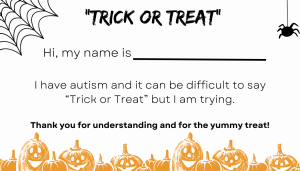Halloween is a tradition that most families have participated in for hundreds of years. Unfortunately, it can be hard on children with autism because of the bright lights and loud noises, having to say trick or treat at each home, navigating the large groups of trick or treaters and social interactions, a change in routine, having to wear a costume, or simply being afraid.
A large part of Halloween is the decorations, lights, and creepy sounds. For many, those are all fun, anticipated parts of Halloween. However, for children with autism who have a sensitivity to light or sounds, it can be overwhelming or even painful. If your child is sensitive to light or decorations, it may be beneficial to drive or walk through the neighborhood, look at decorations before trick or treating, and explain the decorations are for fun and not real. If they are afraid of the dark, bring a flashlight. Make it fun and have glow sticks for them. If sounds are an issue, bring noise-cancelling headphones.
Trick or Treating is a well-known pastime most children look forward to each year. Traditionally, children happily say ‘trick or treat” as they go door to door collecting pumpkins or baskets full of goodies. This pastime can be uncomfortable and incredibly challenging for nonverbal children who have difficulty being verbal around strangers in new settings. A way to help would be to create a bag or pumpkin with a little sign and a message such as, “Nonverbal Trick or Treater – Please Be Patient.” You can purchase bags from vendors online. You can also print cards to hand out so people understand why your child may not speak to them.
Social interactions are almost unavoidable while trick or treating. Most neighborhoods are full of families and groups of children up and down the sidewalks. For children with autism, this can be extremely overwhelming and scary. For instance, to keep our children safe, we teach them “stranger danger,” a rule taught that is especially important to keep children with autism safe. However, on Halloween, we ask them to speak to strangers continuously. For autistic children, this can be very confusing and difficult for those who thrive by following rules. You can prepare your child for trick or treating by reading them books or stories about what to expect while trick or treating. There are countless resources for social stories.
“Trick or Treating” occurs when most children are usually in bed or getting ready for bed. On Halloween, however, they may be up late, out walking a lot, and the lights, decorations, sounds, and people overstimulate some children. This change in routine can often lead to children with autism being painfully overwhelmed, stressed, and anxious, resulting in meltdowns.
Costumes can also be a difficult part of Halloween for children with autism. Most people do not realize that all children do not enjoy dressing up in a costume. Costumes are often made from uncomfortable or scratchy materials. Dressing an autistic child can be challenging to begin with; add in the additional textures or layers, and it could result in sensory overload. Avoiding masks can also be especially important for autistic children. Some children may love dressing up as something scary, a princess, or their favorite animal, or they may prefer dressing up in their clothes. You must find what works best for your child. People in costumes can be frightening and overwhelming to any child. Be mindful of what might overstimulate your child or cause them stress, anxiety, or fear.
Discuss Halloween and “Trick or Treating’ with your child and determine what works best for their needs. While some children will be eager to go out and “Trick or Treat,” others may need to stay home or with a family member.


Written by Lainey McMahon
Mailing address:
4771 Sweetwater Blvd., #358
Sugar Land, TX 77479


